
The Cincinnati Reds underwent significant changes from 2024 to 2025, particularly in their coaching staff. While pitching coach Derek Johnson remains, the team has brought in a new manager, Terry Francona, along with a revamped hitting staff. Former Reds infielder Chris Valaika takes over as hitting coach, assisted by ex-Reds minor league coach Alex Pelaez and newcomer Will Remillard.
One of their primary focuses is helping Elly De La Cruz cut down on strikeouts by refining his swing. Charlie Goldsmith detailed these adjustments in his newsletter, where Valaika emphasized the importance of keeping De La Cruz aggressive but improving his control and forward movement to enhance decision-making.
Strikeouts were a major issue for De La Cruz in 2024—he led the league in total strikeouts and had a 31.3% strikeout rate, ranking among the 10 worst in MLB for players with at least 400 plate appearances. Despite this, he remained highly productive due to his power, strong walk rate, elite speed, and defensive value. According to FanGraphs WAR, he was the ninth-most valuable position player in baseball last season.

A key area for improvement is his swing decisions. While he chased non-strikes 28.2% of the time—just below the league average of 28.6%—his ability to make contact on those pitches dropped from 55.9% in 2023 to 45.1% in 2024, far below the league average of 56.2%. His struggles weren’t necessarily from expanding the strike zone too often, but rather from failing to make solid contact when he did.
Another issue was his reluctance to swing at strikes. De La Cruz swung at pitches in the zone just 58.1% of the time, significantly lower than the league average of 66%, ranking him near the bottom of qualified hitters. Overall, he swung at only 42.9% of pitches, ranking 176th out of 207 players.
His results clearly show why better swing decisions could lead to a major leap. In 2024, he hit just .134 with a .178 slugging percentage on pitches out of the zone. However, on strikes, he hit .317 and slugged .609. The stark contrast highlights how simply swinging at more strikes and fewer non-strikes would significantly boost his production.

Beyond decision-making, De La Cruz also needs to improve his contact rate. On pitches in the strike zone, he made contact 79.4% of the time—down from 82.9% as a rookie and well below the league average of 85.2%.
Even small improvements in these areas—more selective swings, better in-zone aggressiveness, and improved contact rates—could make a massive difference. With his game-changing speed and power, even incremental gains could elevate him to an even higher level.
Of course, spring training optimism doesn’t always translate to regular-season results. Whether these changes make a tangible impact remains to be seen, but if they do, De La Cruz could be in for a breakout year.



Be the first to comment